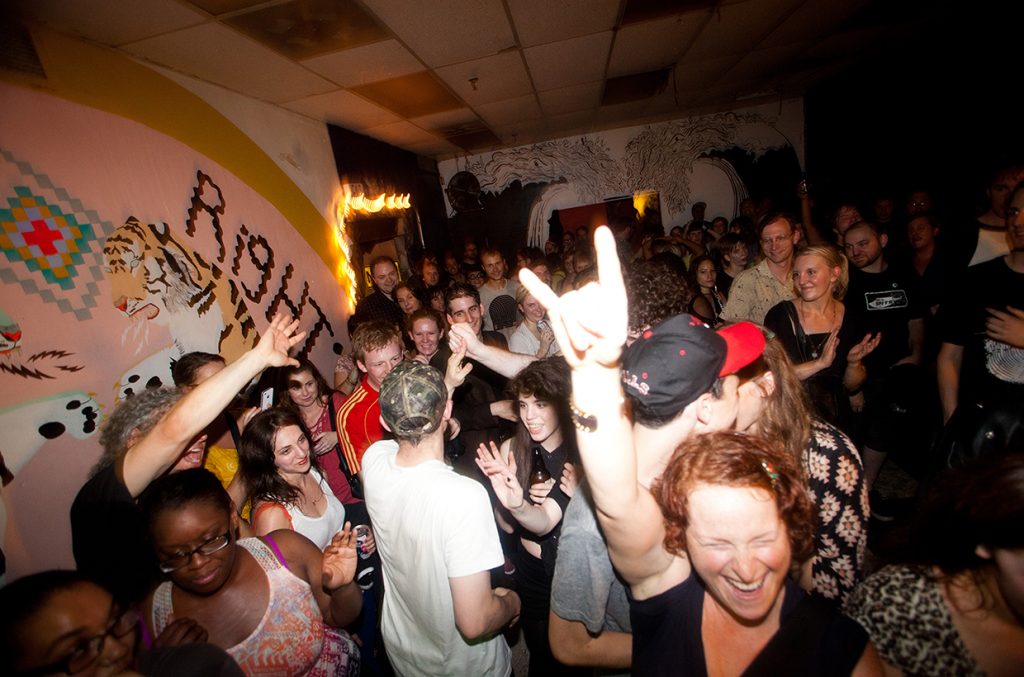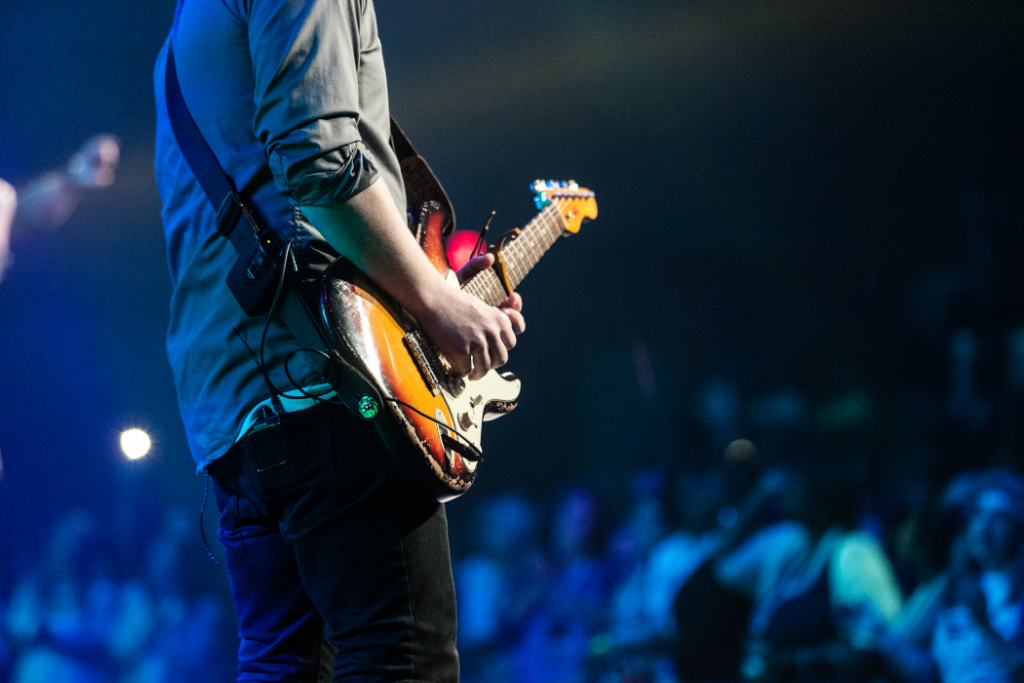+ Our brand new course with The Dillinger Escape Plan’s Ben Weinman teaches how to make a living in music without making sacrifices. Check out The Business of Uncompromising Art, out now exclusively on Soundfly.
By Jhoni Jackson
Putting together a multi-day event in your city requires a little knowledge of booking and who’s who in your local music scene, but it’s not the impossible feat some might imagine. Organizing a festival is within the reach of nearly anyone who’s willing to commit time to planning, researching, and learning.
It’s helpful to remember that DIY is never about flying solo. It’s about working together as a community. Rally friends and fellow contributors in the local scene to join your festival-organizing team. Both the event and your sanity will benefit from sharing responsibilities and the fresh, creative brainstorm that collaborating often sparks. Check out the step-by-step guide below to get started.
1. Determine the Reason
You could organize a festival just for the sake of it, of course. But the most successful events are built around a mission, a purpose. Ask yourself: what’s the reason for this festival?
Consider Ruidosa Festival. This traveling event aims to highlight Latinx women musicians of all genres with a deliberate emphasis on intersectionality.
Another example of an event grounded in social purpose is MACROCK, the longstanding DIY culture fest in Harrisonburg, Virginia. Since the late ’90s, this event has promoted independent musicians and creatives while also providing a forum for education and connections through its panels and expo.
Then there’s the A3C Music Festival and Conference in Atlanta which began in 2005 as a hip-hop showcase and has developed into a massive five-day gathering complete with conferences, film screenings, art, and academic panels.
All three of those festivals have a reason for existing that makes them stand out. What’s yours?
+ Read more on Flypaper: “Why Your Soundcheck Never Sounds the Same as Your Performance”
2. Gather the Lineup
Once you’ve figured out the mission of your fest, the lineup should come easily — or your ideal version of it, at least. Set a goal for how many acts you want to include, then start reaching out to gauge availability and interest. Don’t count on landing every band you want; your dream lineup may not be possible (yet).
One piece of advice is to book the headlining acts as early as possible. When they’re confirmed, you can begin to contact the smaller and local acts on your shortlist and create a long list of backup acts in case some artists fall through or cancel. (There’s always a few).
Budgeting for Your Acts
When building the lineup, you’ll need to consider the cost of each band or artist against what you expect to make. If you’re planning a free event, will you be able to negotiate any payment from the venue? Will you take donations? Ticketed events are a bit easier to calculate, of course.
Figure out how much you’ll charge based on the ideal lineup and multiply it by your estimated attendance, then subtract any operational costs. The result is the sum from which you can pay bands.
Don’t book more acts than you’ll able to afford, and don’t promise anyone a payment you’re not sure you can make. Some bands will be comfortable agreeing on a minimum amount with the promise that, if possible, you’ll add more. Others might not like that agreement, so this could affect who you can realistically confirm for the fest.
3. Add DJs, Vendors, and More
There’s nothing wrong with programming a straightforward lineup of bands and artists, especially when they’re really great live acts. But adding extra elements to spice things up will really help define your festival’s identity.
Get creative and mix things around a bit with performance artists, installations, poets and readings, some food, various lighting combinations and stage designs, etc. Mixing your bills with tons of different acts is a tough balance to strike, but when done right, it will result in a healthily diverse crowd of fans with performers bringing their own followings.
With your mission in mind, think about what you could add that’s not necessarily related to music or performance. Vendors, perhaps? Round up local artists and makers you think your crowd would love and have them pay you a percentage of their sales as “rent.” Not only are you giving folks another reason to check out your fest, but you’re offering a consumer-facing platform for fellow independent and DIY creatives.
This is where you can add more engagement at the event, too. A tarot card reader, a photo booth, a merchandise raffle merchandise donated by local businesses, with funds going to a charity or back to covering the festival’s costs. Think about hosting workshops, panel discussions, and educational seminars as well.
DJs Are a Must
At any show, DJs help keep the vibe lively between bands. At a fest, they can totally save you during unanticipated delays or cancellations. Opening with a guest DJ, possibly someone from a band already on the lineup, can turn a sluggish start, an inherent obstacle to the daytime section in particular, into an enthused setup for the first band. After parties, of course, absolutely require at least one awesome DJ.
+ For tips, strategies, and resources to help you get on tour faster and smarter, check out Soundfly’s popular free course, Touring on a Shoestring.

4. Secure a Location
Keep in mind the scale of your event — how many days it will last, the number of performing bands and artists, whether not you’ll need space for vendors or other activities — when choosing a location.
The obvious options, of course, are local venues already set up for live shows. Booking several nights in a row is a big commitment for any club, so it’s important to know your potential draw to figure out whether or not the space is appropriately suited for a fest. Don’t discount the option of using multiple venues, either. You could secure a sizable spot for the full-day lineup and a smaller one for a shorter opening night, for example.
Fests don’t have to be limited to existing clubs, either. Consider other places that could work for the event. For example, if you’re booking an all-women lineup, reach out to a woman-owned business to host some of the activities.
If you’re looking to organize an outdoor festival, you’ll need permits based on your city’s laws. Do the research. Some of this information is available online, or you can contact your local office for special events to check prices and processes. It can be costly.
If your location doesn’t have a staff on the payroll to work the house equipment, remember that you might be responsible for renting the speaker system and hiring somebody to run it yourself!
5. Find Sponsors to Offset Costs
If your fest is need of extra funding, you may want to consider sponsors. That doesn’t necessarily mean you have to reach out to only big corporations, though. We’ll get into that, but first, what are you planning to offer sponsors in return?
Advertising, of course. But pitching your fest requires details and projections — potential sponsors will want to know exactly how much advertising they’ll get in return to gauge their spending or in-kind donation.
You can offer logo placement on all flyers and posters printed (the more you’re printing, the more enticing the offer for the sponsor) as well as inclusion on a prominently placed fest banner. Include them in your social media strategy, too. Work out a minimum number of posts in which they’re tagged or featured.
Are you going to sell official fest merch? You could include sponsors’ logos there too, whether it’s the back of a T-shirt, koozies, or collectible posters.
If you feel that your community is particularly supportive of your DIY festival event, let them help you build it with a crowdfunding campaign! Soundfly’s one-month mentor-assisted course, Crowdfunding for Musicians, can help you increase your chances of success.

In return, what you ultimately want is money. Free cases of booze can boost income, too. If you’re booking at a venue or any place that sells alcohol, loop in management as you negotiate the offer.
Larger companies have money for sponsorships and similar partnerships allotted within their corporate social responsibility (CSR) budgets, but they’re often hard to reach without an inside connection.
Look to companies that have sponsored other events in your city. Ask around for contact info, and give local reps your best pitch. Selling them on the opportunity for exposure to your crowd and other benefits for their brand is key.
Local businesses are another option, and one you shouldn’t overlook. Small, independent businesses tend to support other like-minded endeavors in theory and, when they can, in practice. It’s the same premise as working with a corporate sponsor. With small businesses, however, working together is also an opportunity to strengthen local culture.
Lastly, depending on your city and state (or country!), there may be grants available to help with your festival. Here’s a helpful guide on how to apply for funding once you’ve found an opportunity for which you qualify.
6. Create a Marketing Strategy
Promoting your festival is not unlike promoting a show, but the pressure can easily feel overwhelming. There are more bands to pay, not to mention the success of the event, which falls on you and your organizing team. Forget future sponsorships if things go terribly, by the way. No pressure, right?
If your marketing strategy is on point, you’re more likely to hit numbers that’ll make everyone happy, from the venue to the bands to vendors and even yourself. Print at least twice as many posters and flyers as you hope to have people in attendance. Be thoughtful about where you hang them, and hand out flyers (don’t just leave stacks around bars) at like-minded shows and events. Try buying a bit of advertising time with a local radio station, too.
Boost your Facebook event early on, then again right before the fest for a final push. Check the reach-to-dollars-spent ratio to ensure you’re getting the message out far and wide. And try to plan weekly social media content in advance so you’re not scrambling to post something last minute (anything from photos or videos of the artists, press write-ups, unique content created for the festival, etc).
In all of this, create a hashtag. Come up with something catchy if you can, or simply use the name of the fest. Include it in as much promo as you can to allow attendees, bands, and other involved parties to pick up on it. It’ll help spread the word and come in handy after the event when you’re collecting photos and videos.
+ From the archive: Back when Pokémon GO was eating our attention spans alive and destroying our ability to interact with other humans, bands and venues found clever ways to market events around the game. Check out our full report on their strategy!
7. Prepare Yourself for the Actual Event
Building a DIY fest is a detailed process. If it’s new to you, it may seem overwhelming. If you stay organized, it’s more likely you’ll successfully check every box. Keep meticulous records of everything: your to-do list, agreements with anyone involved, money spent, deadlines in your timeline, and so on. Commit your time and effort to realizing the festival you imagined, and you’ll likely find organizing feels a lot more natural.
A Few Tips to Remember
- Map out the itinerary of each day or night completely from start to finish.
- Know the individual setup of every performer. Make sure he or she knows what gear is available and what isn’t, what time to load in and soundcheck, and of course, the time of his or her set.
- Have a discussion about when payments will be made. Sometimes it’s best to do the math after the chaos is over, but don’t assume bands are okay with waiting a few days to be paid. Talk about it ahead of time.
- If you’ve got vendors, plot the setup beforehand. Consider lighting for tables if the event is at night. Make sure vendors know when to arrive and who’s responsible for tables (you, the venue, or the vendors themselves).
- Make sure you’ve completed any on-site advertisement obligations with sponsors. Have your entrance situation covered, be it contracting your own door person or using the venue’s.
- Accept the fact that you probably won’t get to fully enjoy the event. Most likely, you’ll be running in circles corralling bands, replenishing merch stock, finding change for the door person, and answering variations of, “What time does X band play?”*
*Posting a schedule on social media is strongly encouraged, but you’ll be asked this question repeatedly anyway.
Lastly, when all is said and done, you’re not actually done. Pool photos from social media (here’s where the hashtag comes in handy) and share them with attendees on the event page, as well as with sponsors, bands, and anyone else involved. Whether you decide to organize a second edition or not, everyone will get a final marketing boost from the post-fest content.
Rev Up Your Creative Engines…
Continue your learning with hundreds of lessons on songwriting, mixing, recording and production, composing, beat making, and more on Soundfly, with artist-led courses by Kimbra, RJD2, Com Truise, Kiefer, Ryan Lott, and Ben Weinman’s The Business of Uncompromising Art.




